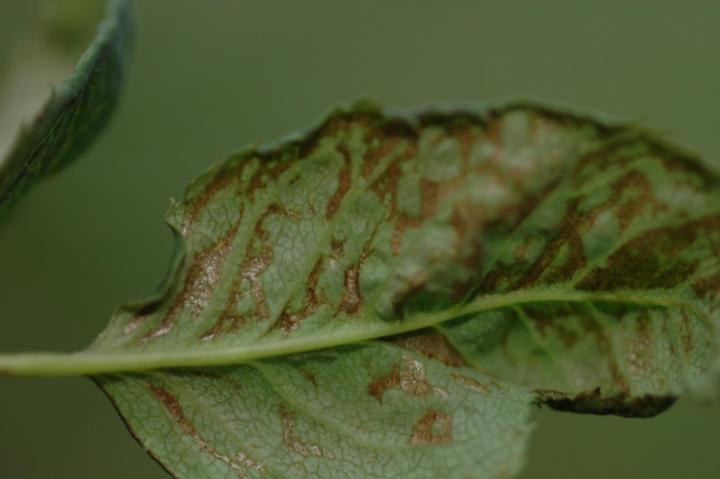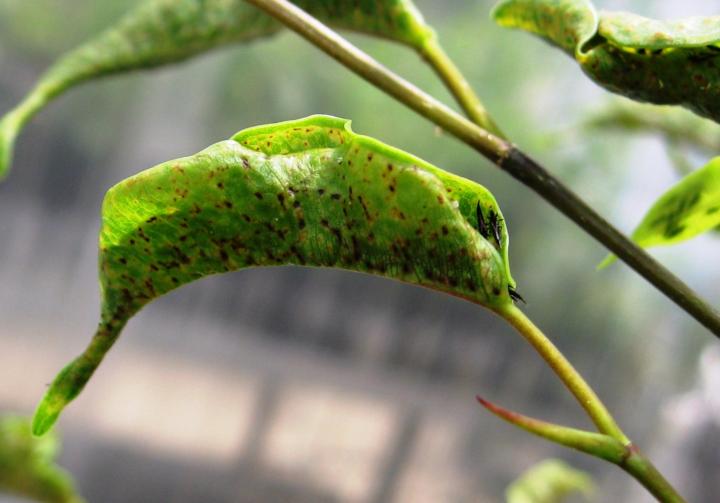
The Western flower thrips is one variety of thrips that can cause extensive damage on over 500 species of plants.
Learn How to Prevent Thrips and Thrip Damage
The Almanac Garden Planner - Use It Free for 7 Days!
Plan your 2025 garden with our award-winning Garden Planner.
ADVERTISEMENT
I love leeks but threw in the towel because I have allium leaf miners and they've ruined my leeks for multiple years. They get in between all the layers of the leek making it impossible to save the crop. This bug/fly comes in spring and fall and lays its eggs. The only help from it is to cover the crop and that can be difficult with crops that grow tall. This pest goes after all related crops such as onion, shallots, scallions and this year I found it in my garlic. If you have any solution to this I’d appreciate any help. I called our state agricultural help line and found out that this is not an easy fix. I live in S Ct.
I need a lot of help with my plumerias. I have been growing plumerias for one year so I’m still learning. I have 25 plumeria plants. my plumeria started to go into dormancy around October 2024, I noticed a lot of black and white tiny flies. I wiped every leaf top and bottom, stems and main stalks with neem oil and thought I had gotten rid of these annoying tiny flies. A few weeks ago as my plumerias were coming out of dormancy I notice the tiny black flies were back and multiplying rapidly. I have sprayed the plants and soil with neem oil, a couple of times, but the flies and still multiplying? I have so far taken 7 of my plumerias outside to removed all the potting mix from the plant to include washing the roots. And clean the pots. I have Re-potted the plants in new potting mix and watered them. The 7 plants I are outside to separate them from the other 18 plants that are in my sunroom I still need to clean and re-pot as well as spray with neem oil. What is the most effective way to get rid of the tiny flies and ensure My plumerias don’t get infested again? I appreciate any advice you can give me.
Hi, Jo An,
For best control, try to identify what species these black and white tiny flies are; your county’s Cooperative Extension might be able to help you.
https://www.almanac.com/cooperative-extension-services
Adults of many whitefly species are white, but the nymphs can be different colors, such as black.
However, if the flies have both black and white markings, could these be fungus gnats? These grayish black gnats feed on organic matter and are a common pest of houseplants (including plumerias). They are especially troublesome if the soil does not dry out between waterings (dry to a depth of about 1 to 2 inches deep), or if water remains in a saucer underneath the pot. The flies will lay eggs in the soil, and the larvae will feed on organic matter, algae, and fungus, and will also nibble on roots; they’ll mainly inhabit the top 2 or 3 inches of soil. Fungus gnat larvae are of special concern for young plants but can sometimes be a nuisance for established ones. The adults do not feed on plants (or bite humans), but the numbers of flies flitting around the plant can be irritating. For more about this pest and its control, see:
https://www.almanac.com/pest/fungus-gnats
Some controls/preventions include: Place yellow sticky traps around the plant to catch adults so that they can’t lay eggs. Repotting with new soil, cleaning the pots, isolation, etc., are all good things to try to control these pests. (Plants outside, however, can pick up more fungus gnats and other pests, so be sure to inspect them and their soil before bringing them indoors.) Be sure that pots have drainage holes and a well-draining potting mix. You might also try adding about a 3/4- to 1-inch-deep layer of horticultural sand on top of the potting soil to deter adult flies from laying eggs in the soil. Keep the soil free of debris, such as fallen leaves.
Hope this helps!
How long do you soak glad bulbs in the Lysol water before planting?
Hi Helen,
You will want to soak your gladiolus bulbs in the Lysol/water solution for 3 to 6 hours. Hope this helps!
I’m looking for help with Thrips and houseplants!! Started with battling fungus gnats brought in from the yard, my potting soil is free of pests.. Have gone through sticky tape, peroxide, Neem oil, mosquito bits and even Ortho Home Defense in the soil, yea, I saw the ones in the soil, it was either them or me..
I did not have this problem just 35 miles north of here… interesting! Any help would be appreciated and (I also use a couple of drops of dawn in my misting water and run a fan and dehumidifier).
Hi Blanche,
Sorry to hear about your thrips issue.
Try applying an insecticidal soap. Make sure leaves, flowers, and growing tips are well covered with the spray. You may need to apply the spray frequently until the problem is under control. You can also try a horticulture oil spray, which can help control thrips as it suffocates the insects. Just make sure to follow label directions to avoid damage to some plants that may be sensitive.
After you have applied control measures, keep plants moist and increase humidity. Plants that are kept too dry are more likely to be damaged by thrips.
I do Rose Photography and plant them around San Diego CA. The most problem we have is Trips and Spider Mites. The trip goes inside Blossom and eats juice of Rose paddles and the top of Paddles becomes black. I use BioAdvanced just reduce them. Spider Mites is also used by this brand. the water around F 98 spray back leaves can reduce them. you can see my roses using this web address. https://www.flickr.com/photos/irajnz/51961058998/in/dateposted/
Hello, well..... this is getting very....VERY sad. I have a 40ft Ficus tree covered with thrips top to bottom and dropping piles of infected Leaves everywhere. it is over 40 Years old and never had a problem. Also a 5 ft Ficus in a pot is also becoming covered 50 ft away Now has it. I have tried the yellow sticky things......No use at all. then Tried spraying. Not great outcome for either.... the leaves shrivel up and the VERY....VERY small bugs inside are alive......What is amazing is....something that small that can do this much damage is quite amazing.
@karenhinds -
I'm having the same exact issue with them biting me. They are driving me crazy. Have you found anything that helps?












